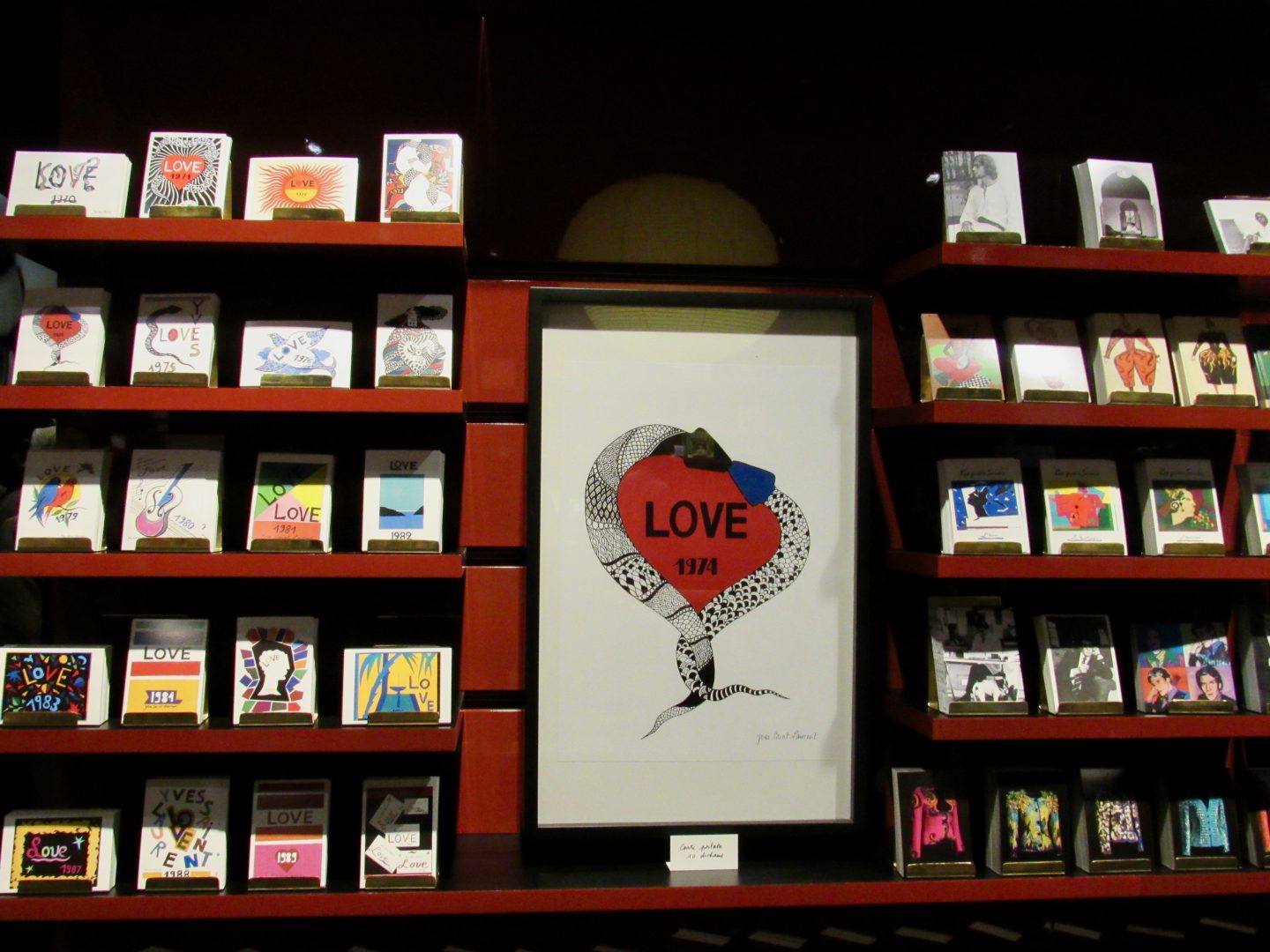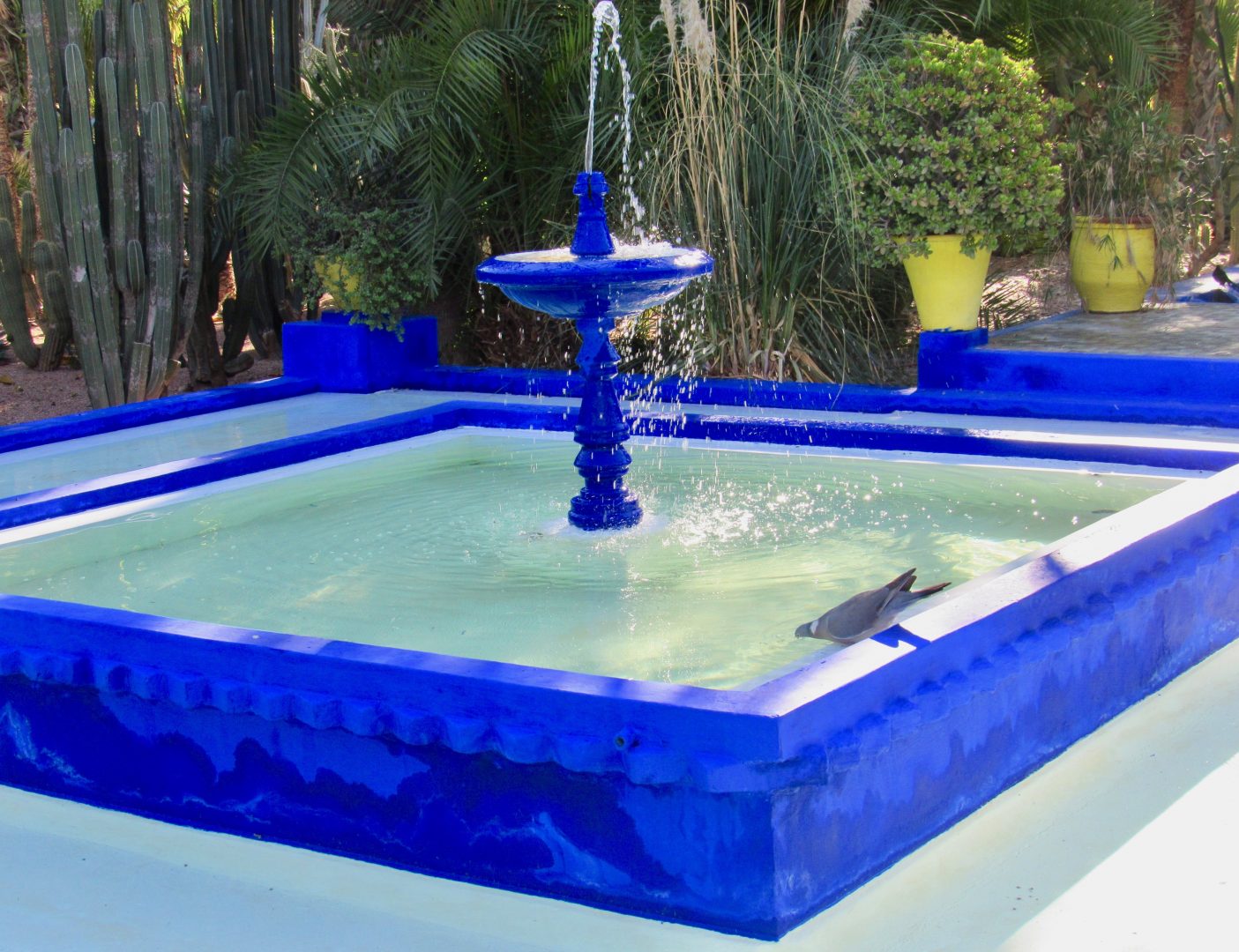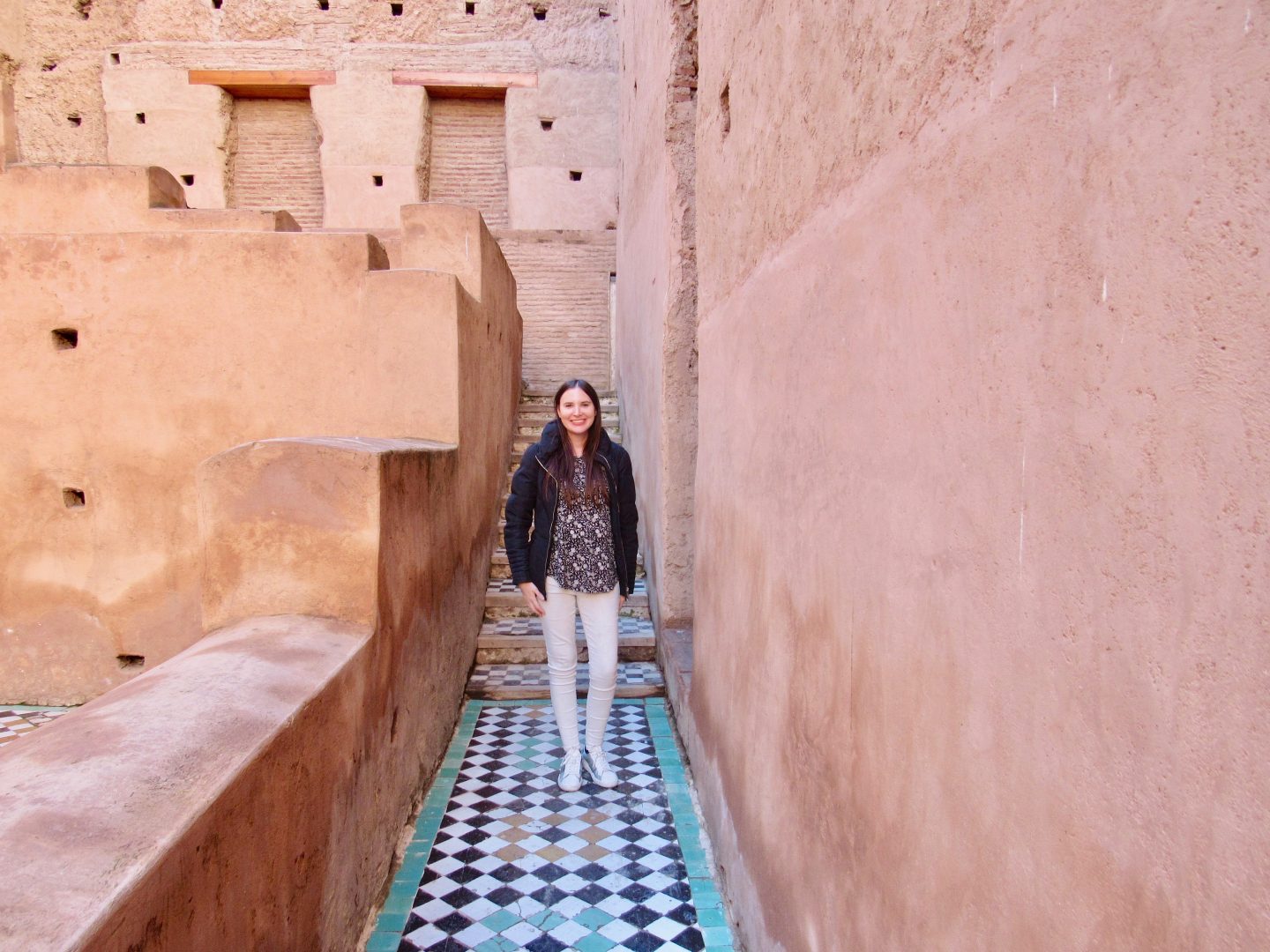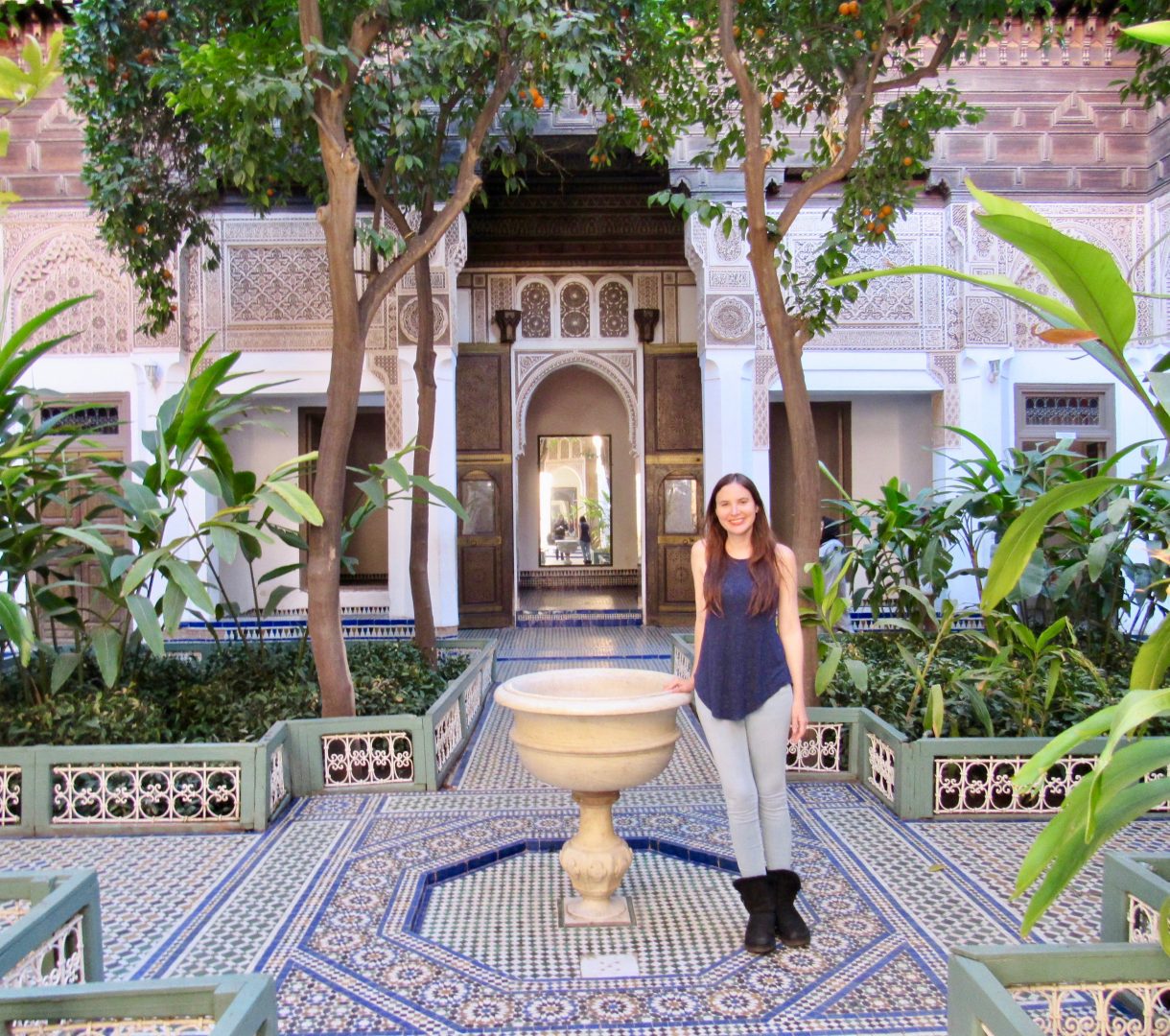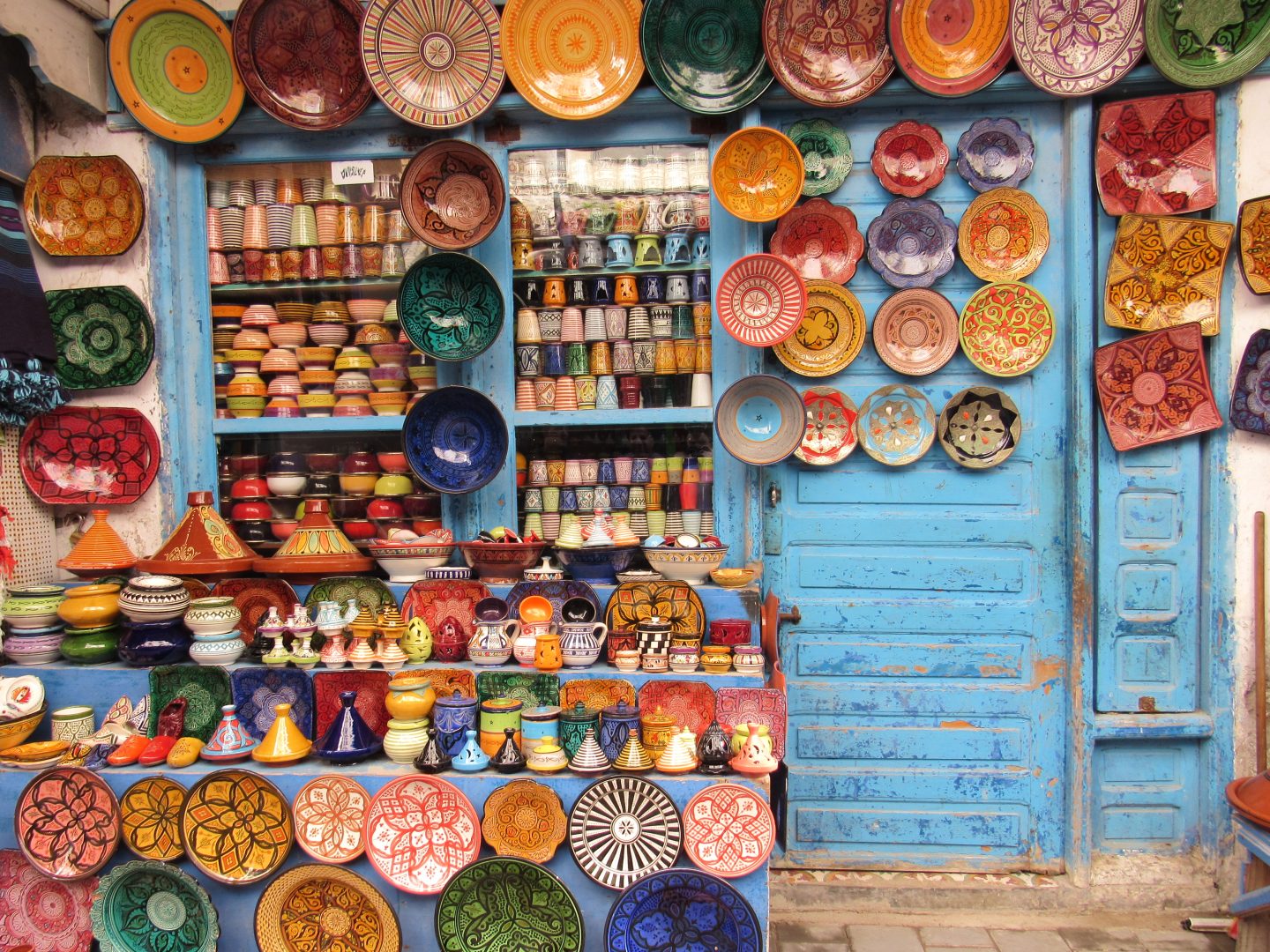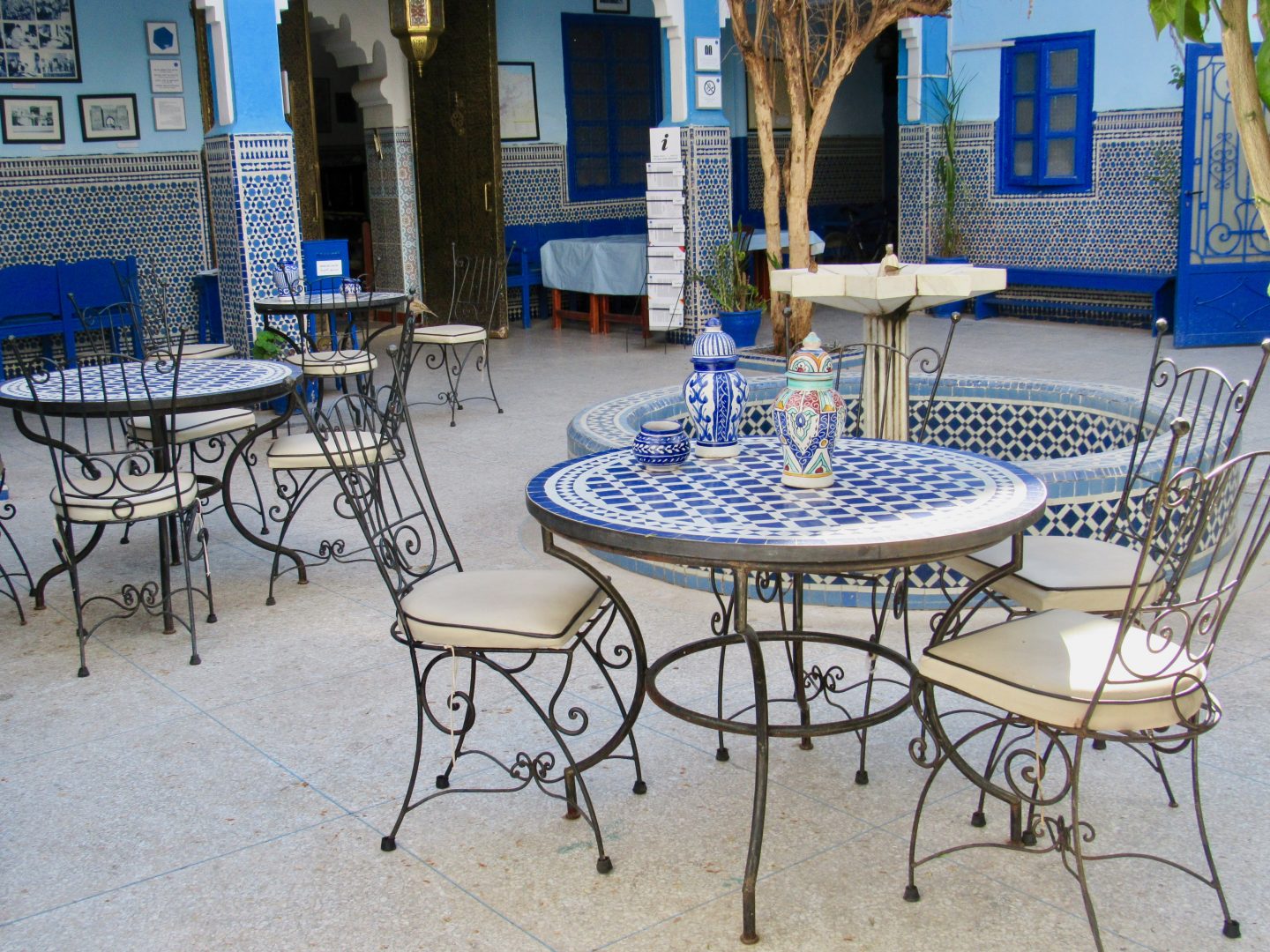Sin duda uno de los lugares más fotografiados de Marrakech es el Jardin Majorelle. Lograr esto no es algo fácil ya que esta ciudad en Marruecos está llena de sitios coloridos perfectos para los amantes de las fotografías como el Palacio de la Bahía. Los que buscan fotos de Marrakech en Instagram van a encontrar miles de fotos tomadas en estos jardines donde los colores y las plantas sirven como los mejores fondos.
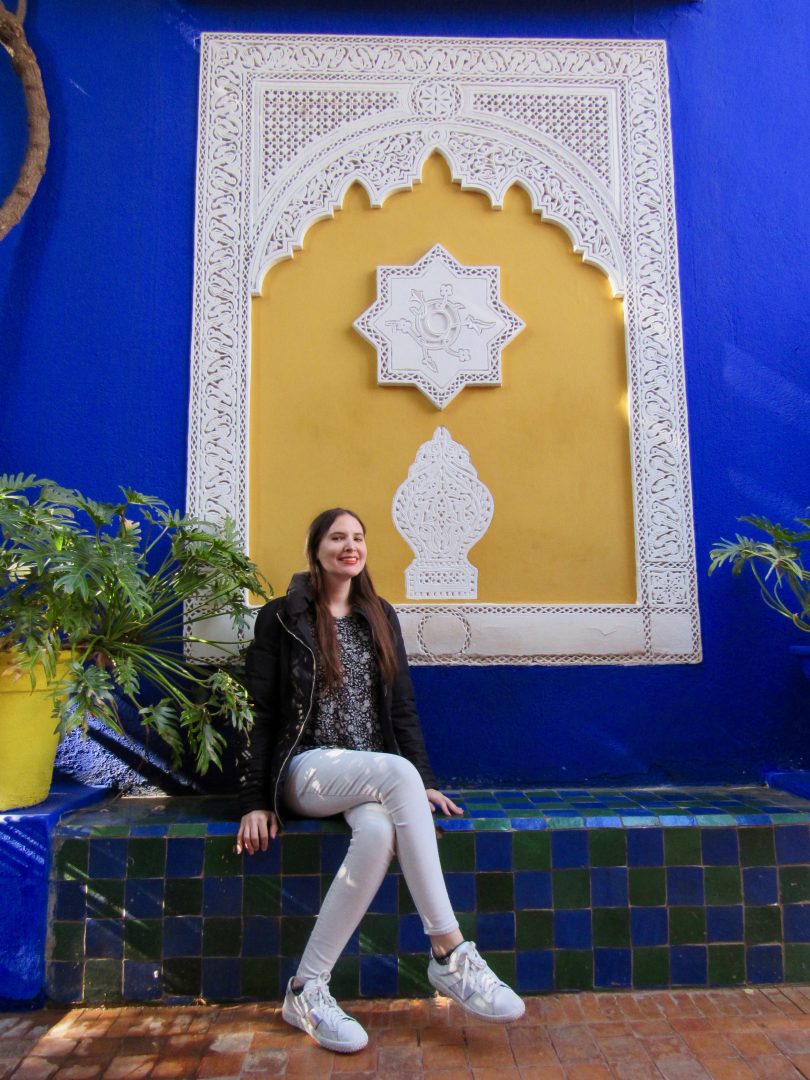
Jardin Majorelle es una de las pocas atracciones que no queda en la Medina, sino esta en Guéliz que es un barrio europeo creado por los franceses durante la época del protectorado. Compre una tarjeta SIM (son muy económicas con data) y tenia acceso a Google Maps, así que decidí caminar la media hora desde mi hotel Riad Chorfa a los jardines.
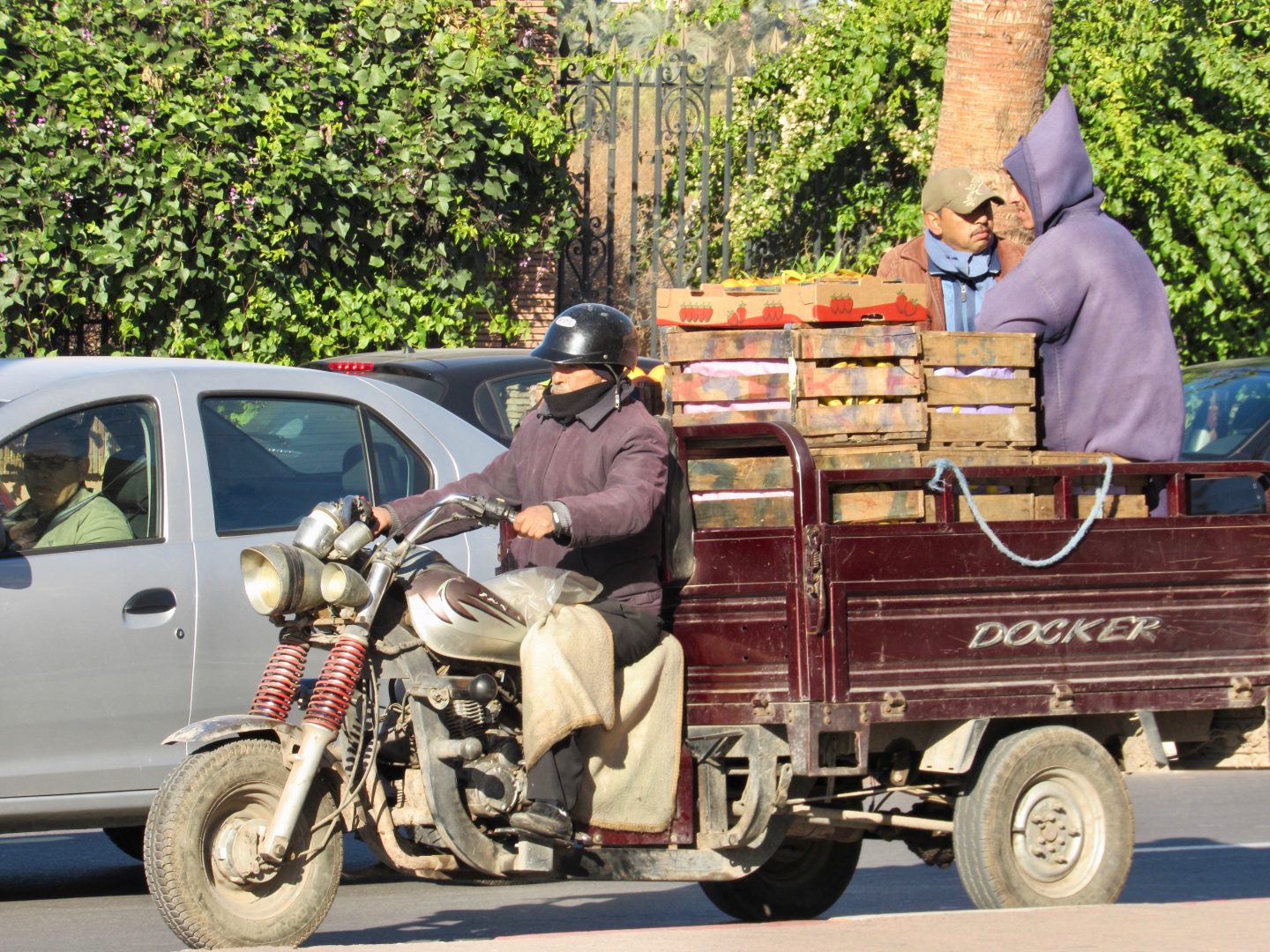
Los jardines abren a las 8 a.m. así que decidí desayunar temprano e ir por la Medina ya que es bastante tranquila en la mañana. Los comerciantes están apenas montando sus puestos, así que no hay tantas personas como en otras horas y puedes caminar con calma. Vi zonas de Marrakech que no conocía, incluso pase por un mercado donde puedes comprar frutas y verduras crecidas en Marruecos. Las fresas y naranjas se veían deliciosas.

La última parte de mi trayecto ya tuvo más trafico de carros, ya que en la Medina se ven muy pocos. Puedes tomar un taxi para ir a Jardin Majorelle o también un carruaje de caballos que es muy común para los turistas. Debes negociar precios siempre.
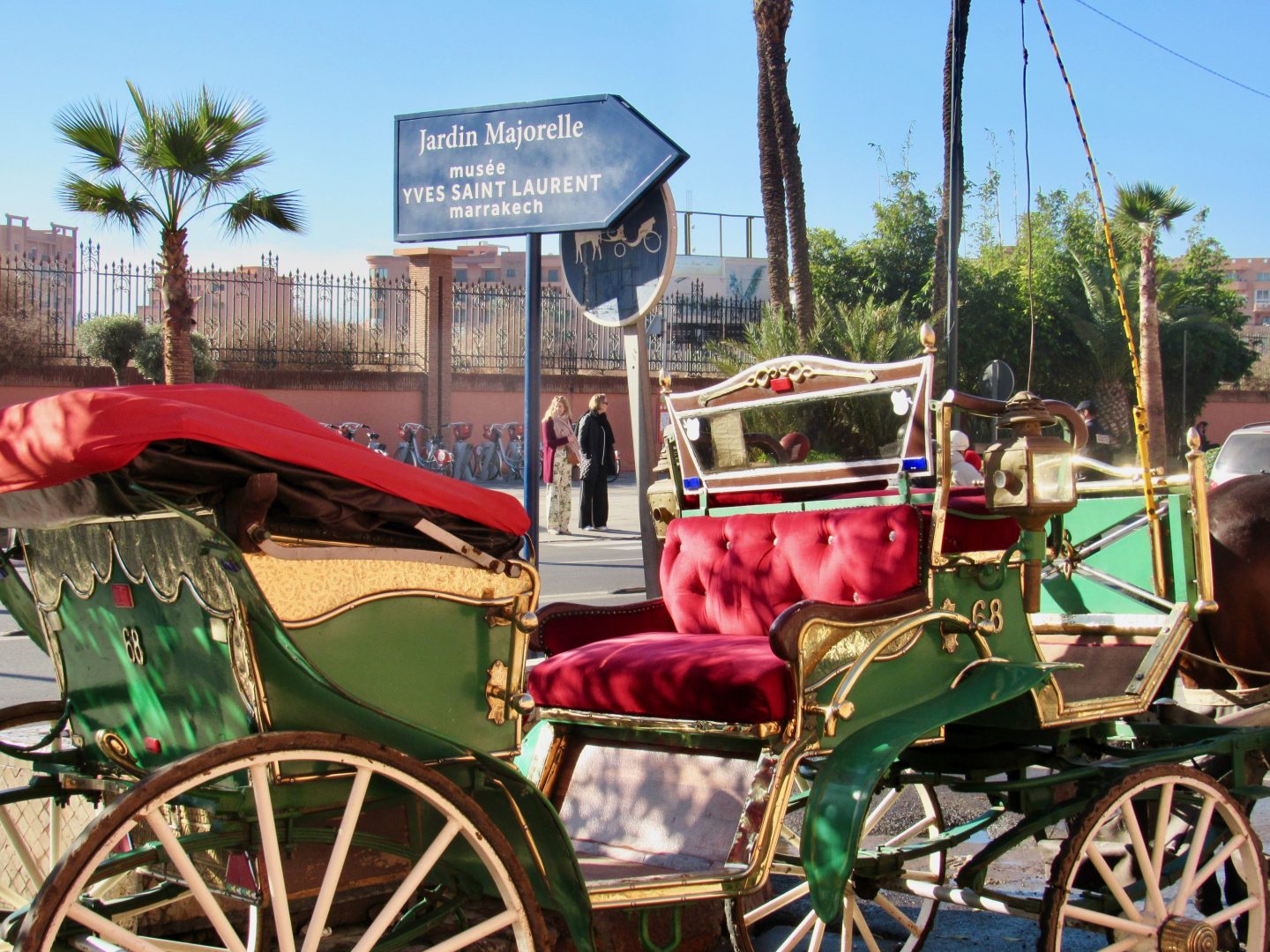
Es recomendable ir a los jardines cuando abren o cuando cierran. Las filas para entrar son eternas como son una de las atracciones turísticas más populares de Marruecos. Reciben 700,000 visitantes por año. Cuando fui a las 9 a.m. no había fila pero cuando salí del jardín habían más de 200 personas esperando.
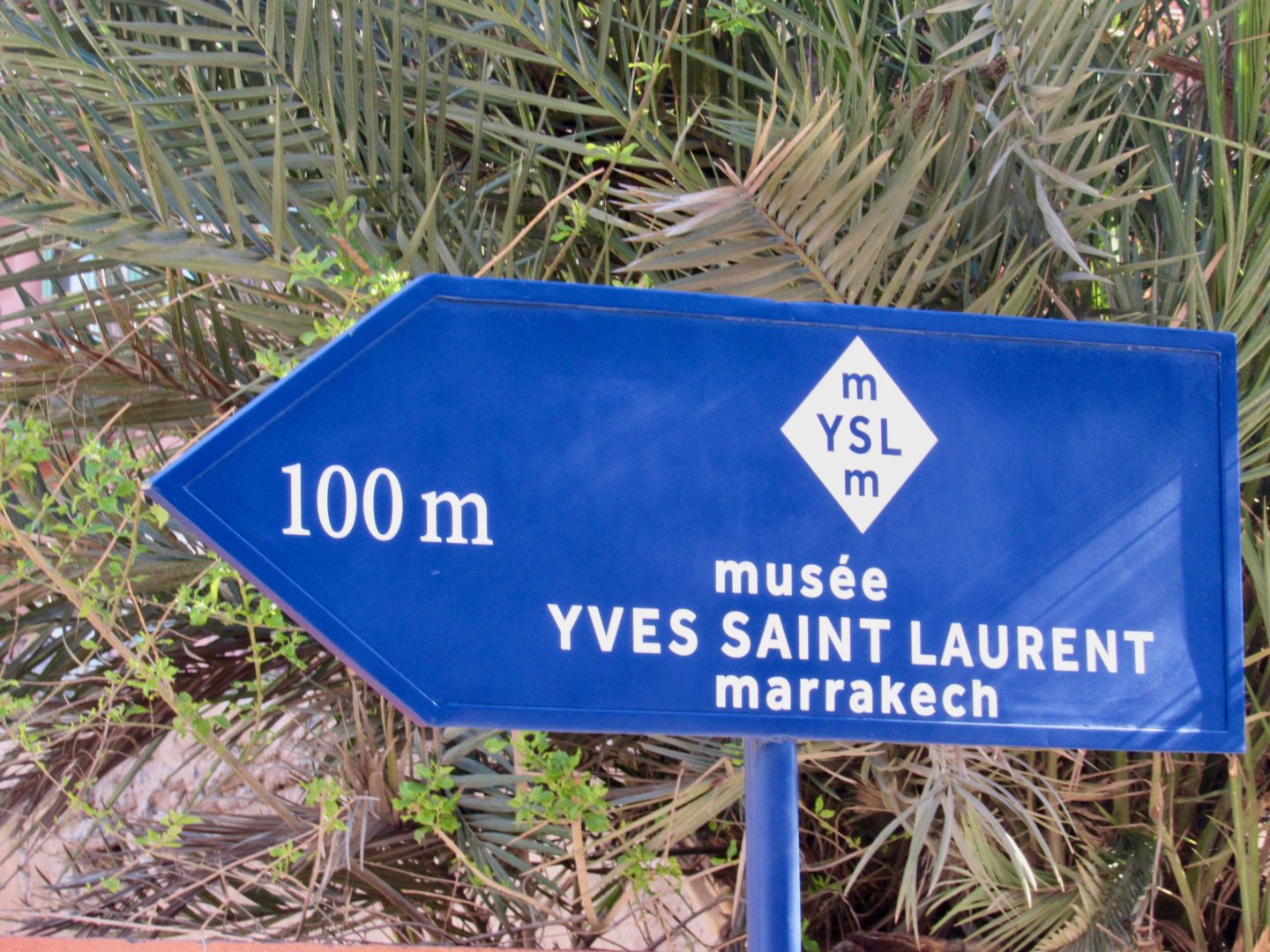
Pasa una mañana en el Jardin Majorelle
Este jardín es uno de los más famosos de África, especialmente al norte del Sahara. La ciudad cambio el nombre de la calle a Rue Yves Saint Laurent como agradecimiento al diseñador que compró la propiedad de Majorelle. El 27 de noviembre, 2010, Su Alteza Real la Princesa Lalla Salma dio a conocer el nuevo cartel de la calle.
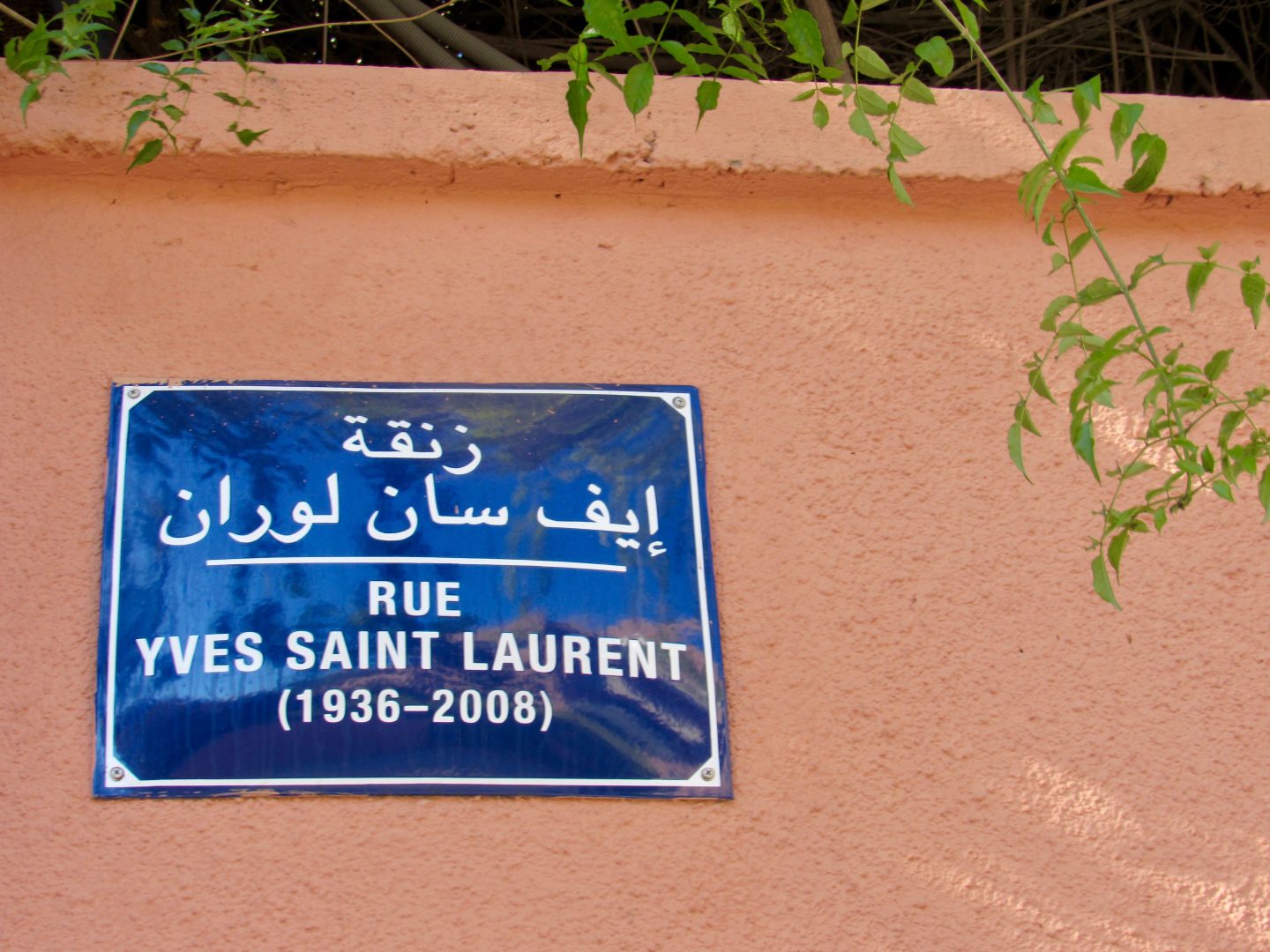
Al estilo típico de Marruecos, las personas cuando ven las paredes rojas naranjas que rodean el sitio, jamás se imaginarían lo que hay dentro. Más de 300 plantas de cinco continentes crecen en el Jardin Majorelle y es impresionante la altura de las palmas y los cactus.
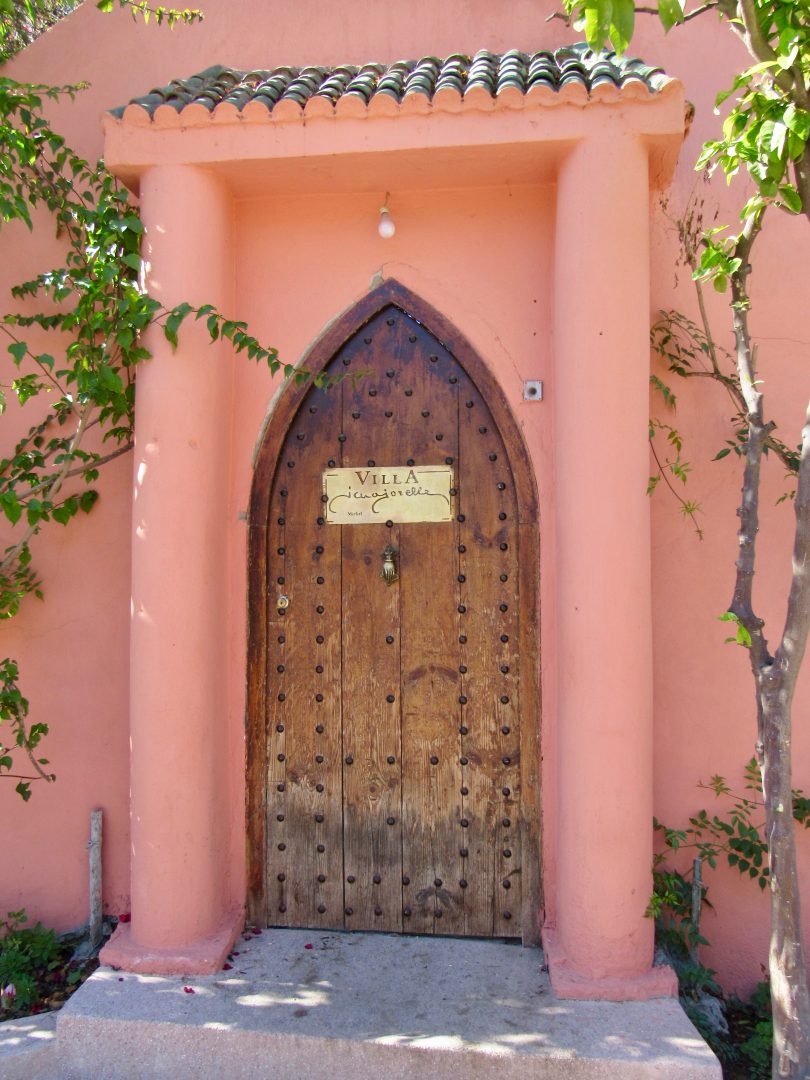
Por la cantidad de plantas, el clima es más agradable y hay menos calor que en el resto de Marrakesh. Esto logra hacer que la gente quiera pasar tiempo sentada en las bancas, mirando las fuentes de agua y la vegetación. Dentro del Jardin Majorelle hay un pequeño monumento conmemorativo a la vida de Yves Saint Laurent que fue diseñado alrededor de un pilar romano que fue traído de Tánger.
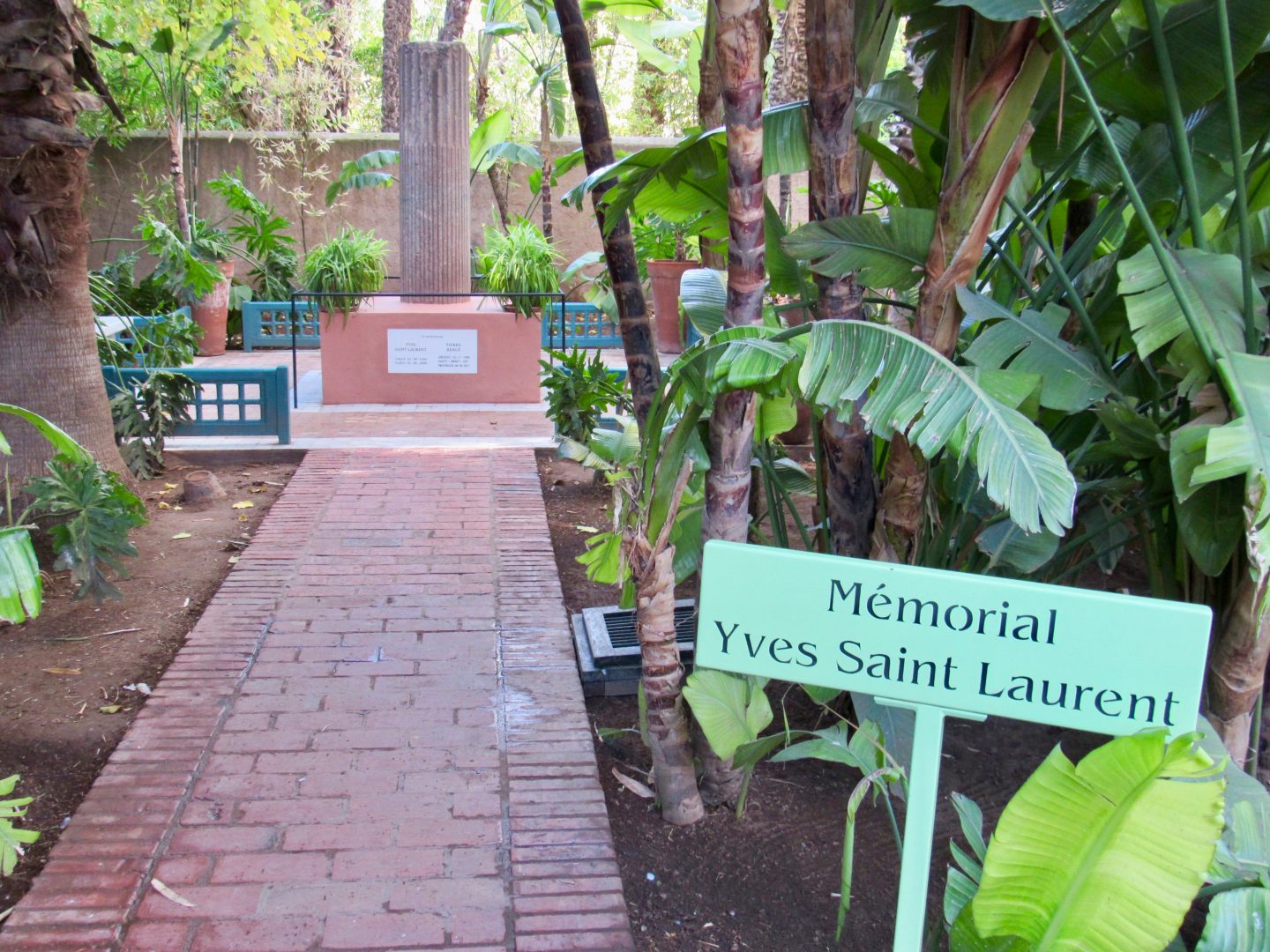
3 opciones de tiquetes
Cuando llegas a la taquilla te dan tres opciones: jardín, museo beréber y museo Yves Saint Laurent. Este es el primer museo beréber en Marruecos que muestra 600 artefactos de los habitantes indigenas de Marruecos.

La colección incluye piezas madera, cuero y metales, además de textiles, instrumentos musicales, atavíos religiosos, y una exhibición de los diversos trajes regionales tradicionales. Además puedes encontrar joyas cinceladas, filigranadas y esmaltadas. Este museo originalmente fue el estudio del pintor Jacques Majorelle y tiene una colección de sus obras.

Hay una boutique que vende souvenirs costosos, incluyendo piezas de vestir, además de libros. Puedes tomar un café o té de menta (la bebida nacional de Marruecos) en el café del jardín. Si tienes hambre tienen opciones de desayuno y almuerzo.
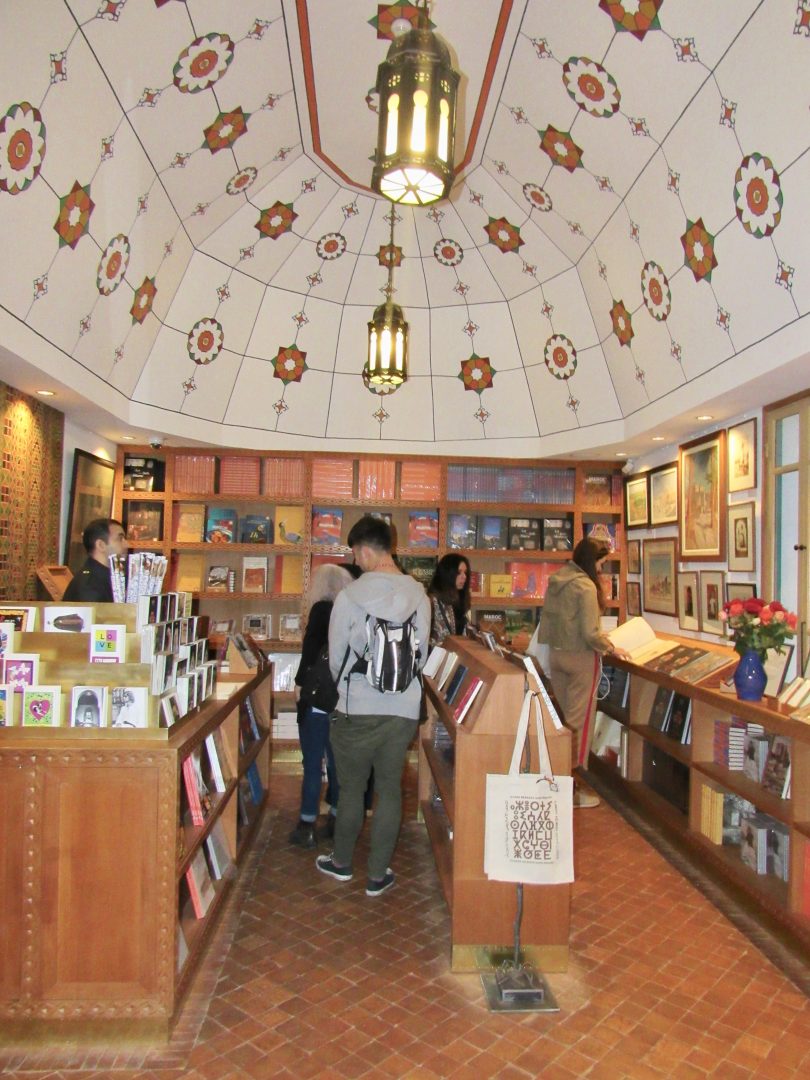
Uno de los cuartos que más me gustó es el que tiene algunos carteles diseñados por Yves incluyendo su famosa colección de “LOVE” que cambiaba cada año. En el centro hay una pequeña biografía del diseñador.
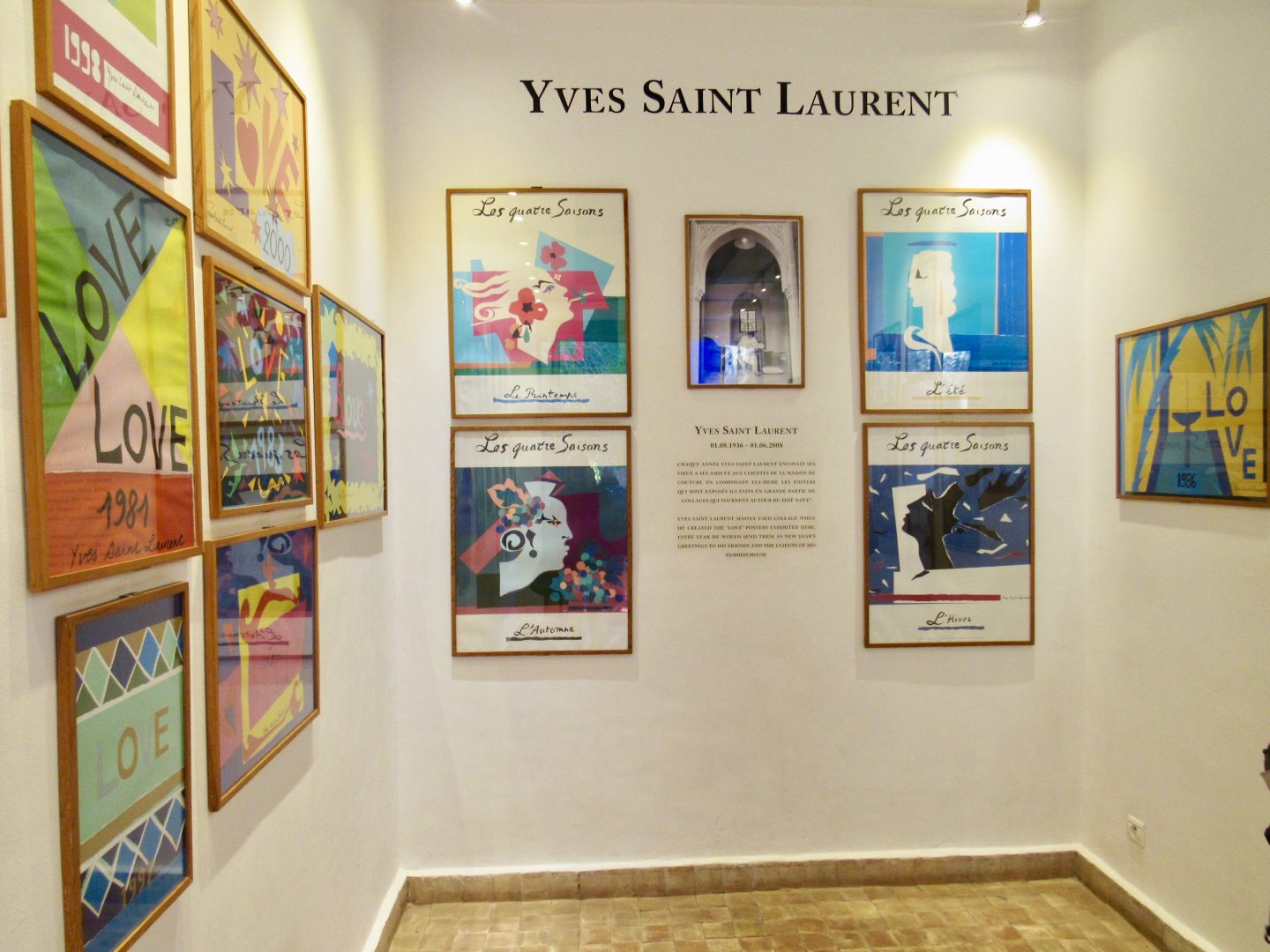
Visitar el nuevo museo de Yves Saint Laurent es bien costoso, personalmente no me pareció que valió la pena por el precio que cobran. Este museo abrió en octubre del 2017.

Jacques Majorelle fue un amante de la jardinería y la cultura islámica
Jacques Majorelle nació en Nancy, Francia en 1886. Su padre fue Louis Majorelle, un famoso diseñador de muebles. Por lo tanto, Jacques creció en un mundo de arte, cuando el Art Nouveau estaba en su apogeo. Este movimiento se inspiraba de formas encontradas en la naturaleza y Majorelle creció amando la flora y la fauna.

Visitó Egipto y se quedó viviendo allí por 4 años. Se volvió un amante de la cultura y el mundo islámico. En 1917 se enferma y lo mandan a Marruecos para recuperarse. Llega a Casablanca a la casa de un general amigo del papá, pero decide mejor irse a Marrakech. Se enamora de esta ciudad llena de colores y mercados; y decide utilizarla como base para explorar África.
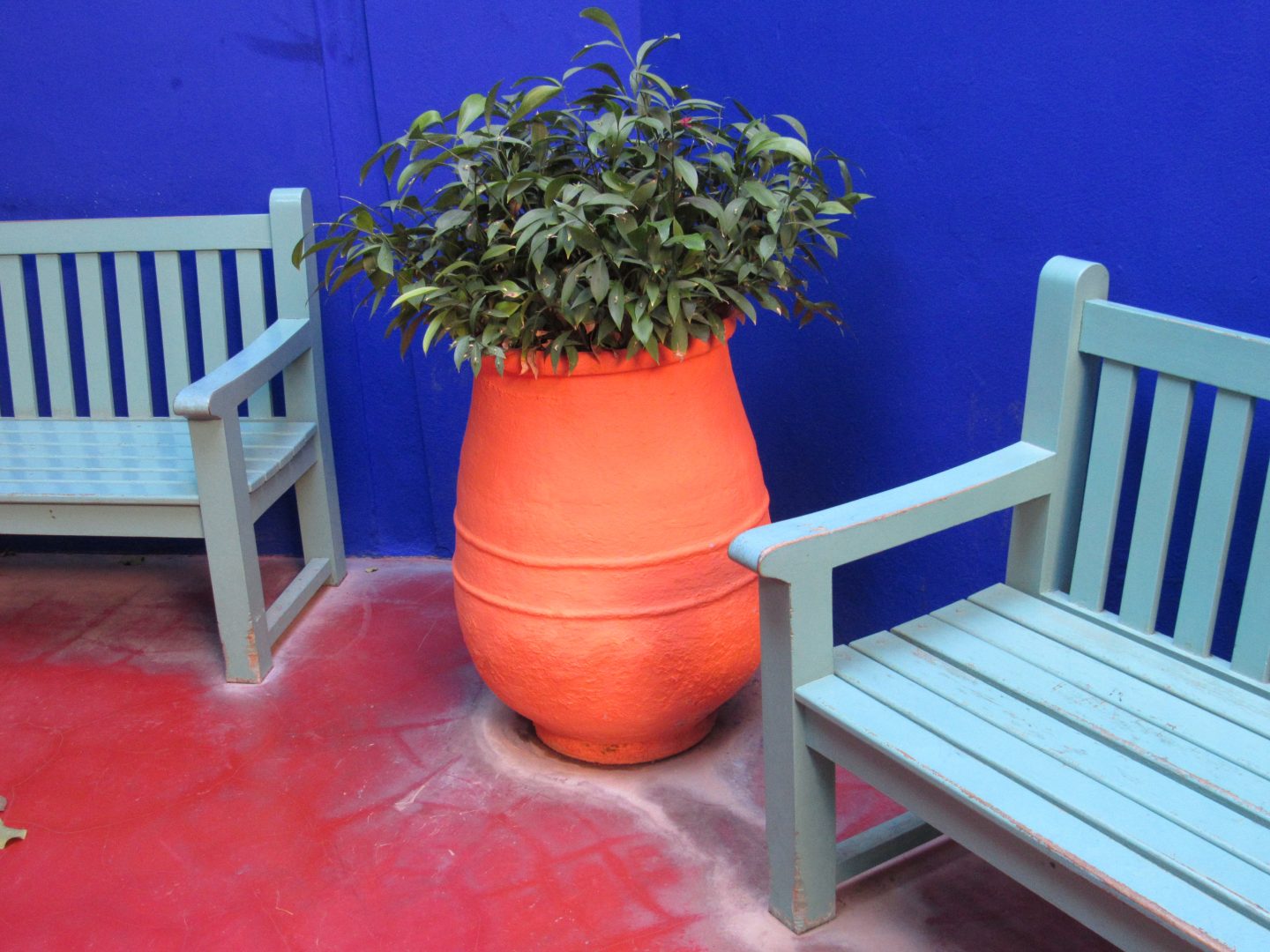
Dos años luego, ya casado con su esposa Andrée Longueville, se muda permanentemente a Marrakesh y en 1923 decide comprar 1.6 hectáreas situadas en el borde de un palmeral. En 1931 le pide al arquitecto Paul Sinoir que diseñe una villa estilo cubista para la propiedad que ya era de 4 hectáreas. Pasó 40 años plantando su jardín que empezó a ser conocido como Jardin Majorelle. En 1947 abrió el jardín al publico para poder pagar los altos costos de mantenerlo.
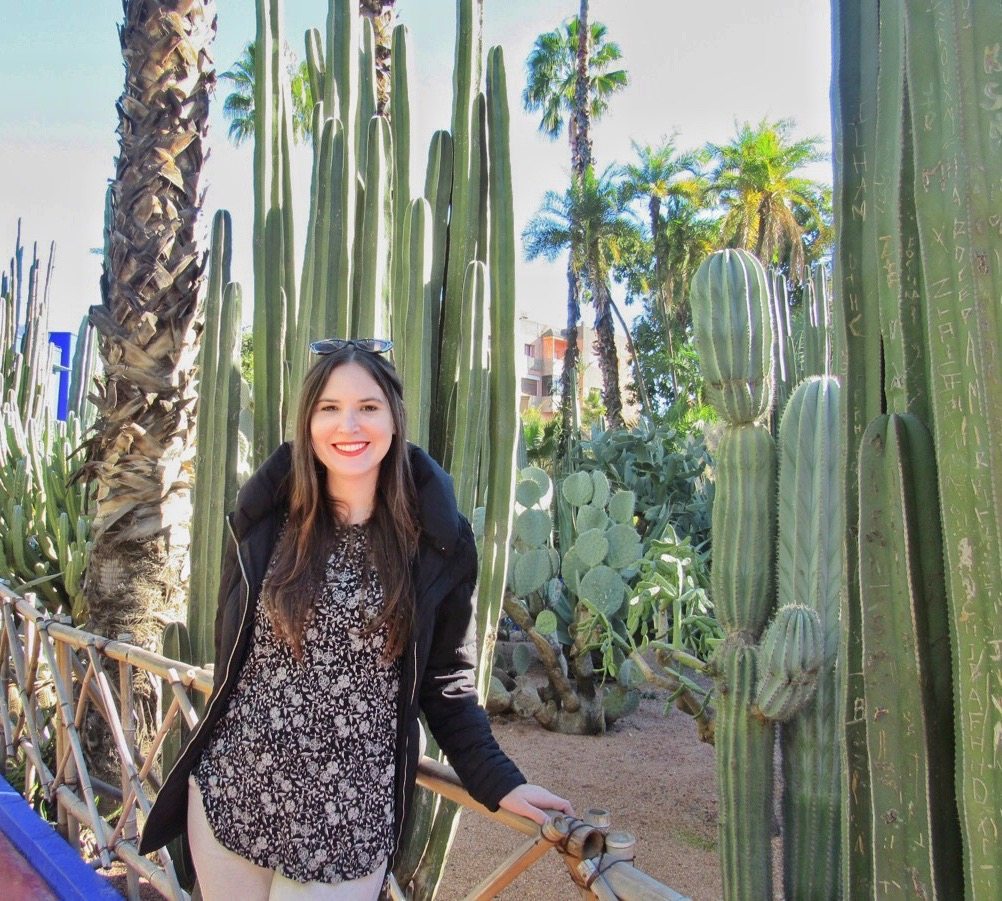
El pintor se divorcia en los años cincuentas. Luego sufre de un accidente de carro que le termina costando la pierna. Por problemas económicos se ve obligado a vender la casa y el jardín queda descuidado. En 1980, Pierre Bergé e Yves Saint Laurent compran la propiedad salvándola de ser destruida para construir un hotel y un proyecto residencial. La pareja había descubierto el jardín durante su primera visita y fueron casi todos los días. Estaba abierto al público pero iban muy pocas personas.
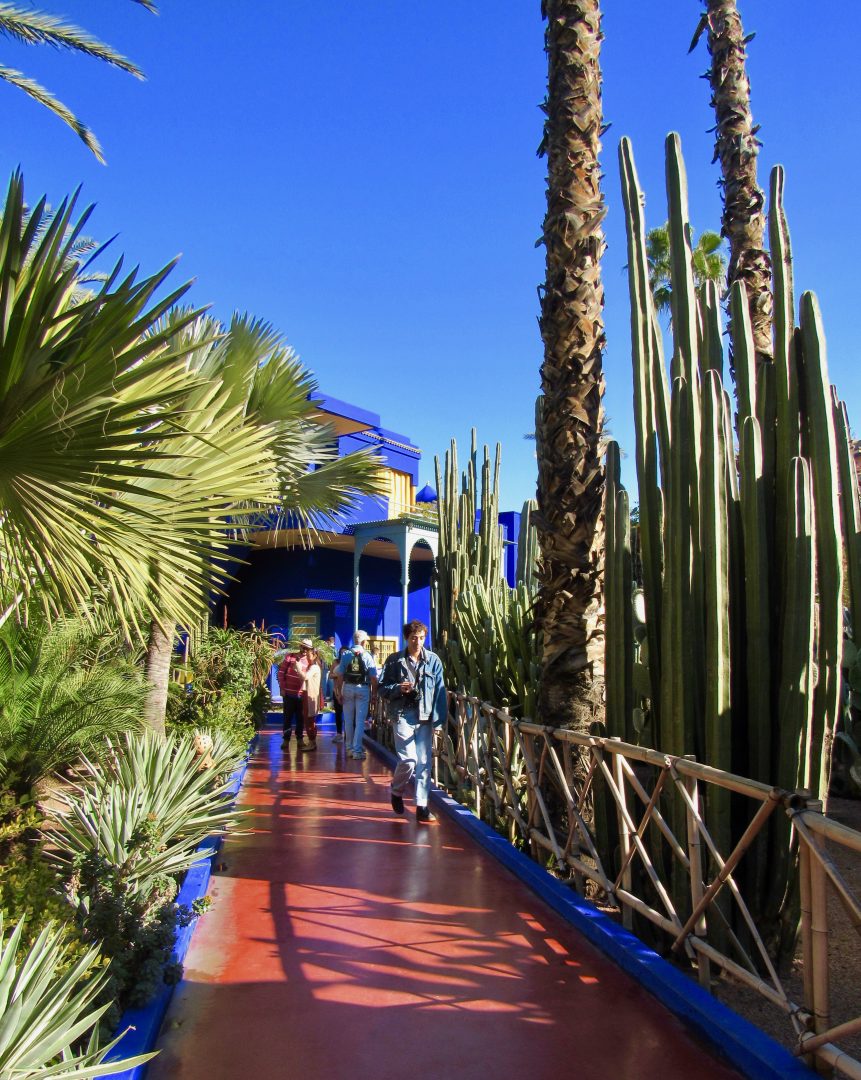
Marojelle crea un tono de azul único
Majorelle fue un pintor inspirado por el Oriente, en su tiempo en Marruecos hizo expediciones a pueblos y souks que le brindaron inspiración para sus obras. La vida cotidiana en Marruecos llena de colores, usando metales incluyendo oro y plata eran representativos en sus obras. Después de 1930 se puso a pintar mujeres negras desnudas y también diseño carteles para promover Marruecos como destino turístico.

Probablemente su mayor logro, aparte del jardín, fue el audaz color azul cobalto que creó inspirado por los mosaicos que había visto en Marrakech y en las casas de los beréberes. Este color es utilizado en su propiedad es contrastado con un amarillo intenso. Antes de morir patentó el color llamado “Azul Majorelle.” Fui a una farmacia natural en Marrakech, donde también venden tintes naturales. Ellos me mostraron la rapidez con el cual se pinta el agua de este tono de azul.
Yves Saint Laurent y Pierre Bergé se enamoran de Marruecos
Yves Saint Laurent nació en Oran, Alegria. Al igual que Majorelle, pasó toda su vida entre Francia y el norte de África. Yves y su pareja Pierre llegaron a Marrakech por primera vez en 1966 y nunca se fueron. La ciudad influenció al diseñador. La moda, jardines, colores y artesanías locales hicieron que sus diseños evolucionaran.
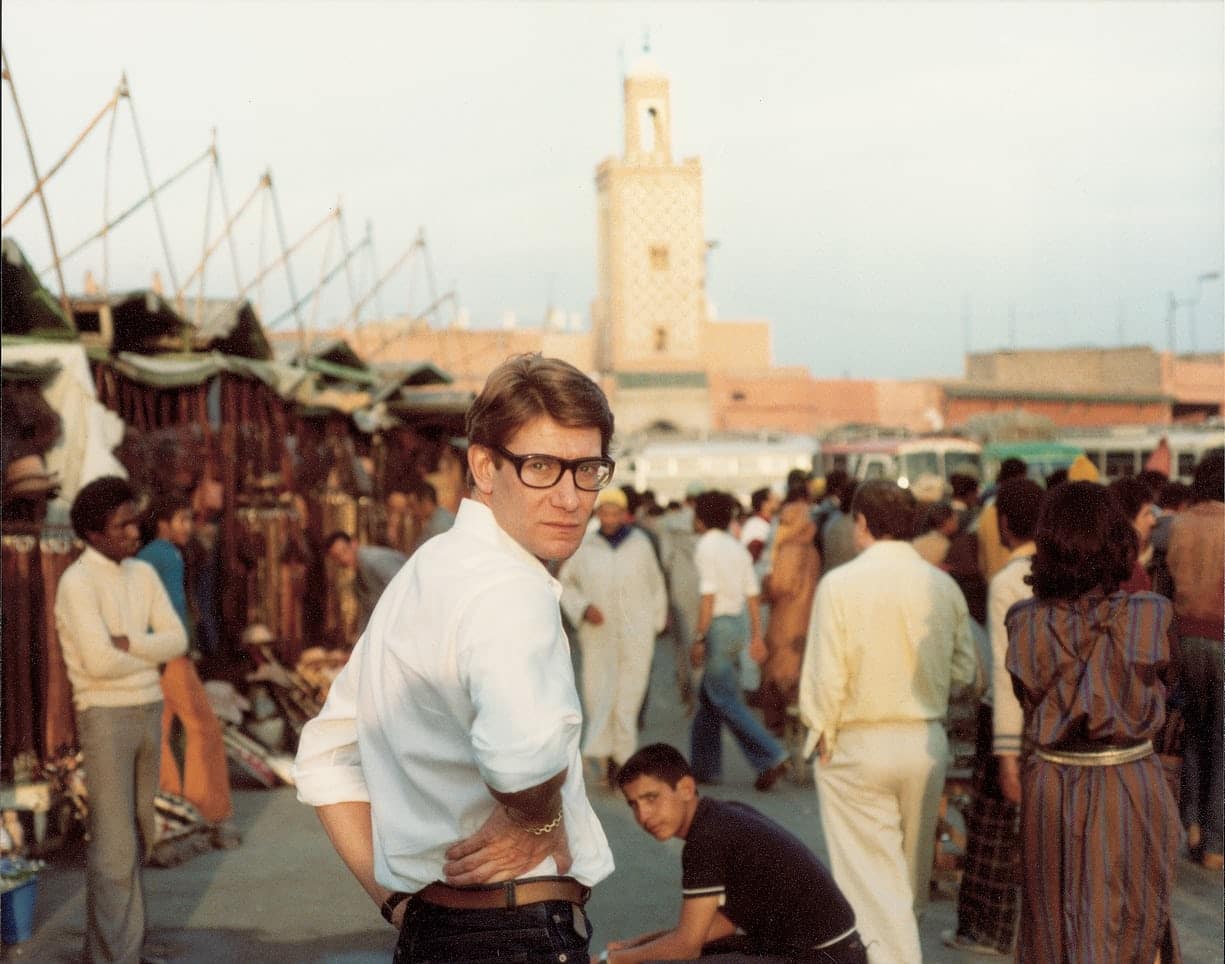
“Marrakech me enseñó el color; antes de Marrakech, todo era negro,” dijo Yves Saint Laurent.
El diseñador tuvo una carrera de 40 años, desde 1962 hasta que se retiró en el 2002. Yves muere el 1 de junio del 2008 en Paris, pero sus cenizas fueron regadas en el jardín de rosas en Villa Oasis, la casa privada junto al Jardin Majorelle.
Desde el 2011 la propiedad ha sido manejada por la Fundación Majorelle para garantizar la preservación del jardín, que actualmente es mantenido por 20 trabajadores. Pierre Bergé fue el director de la fundación hasta su muerte en septiembre, 2017.
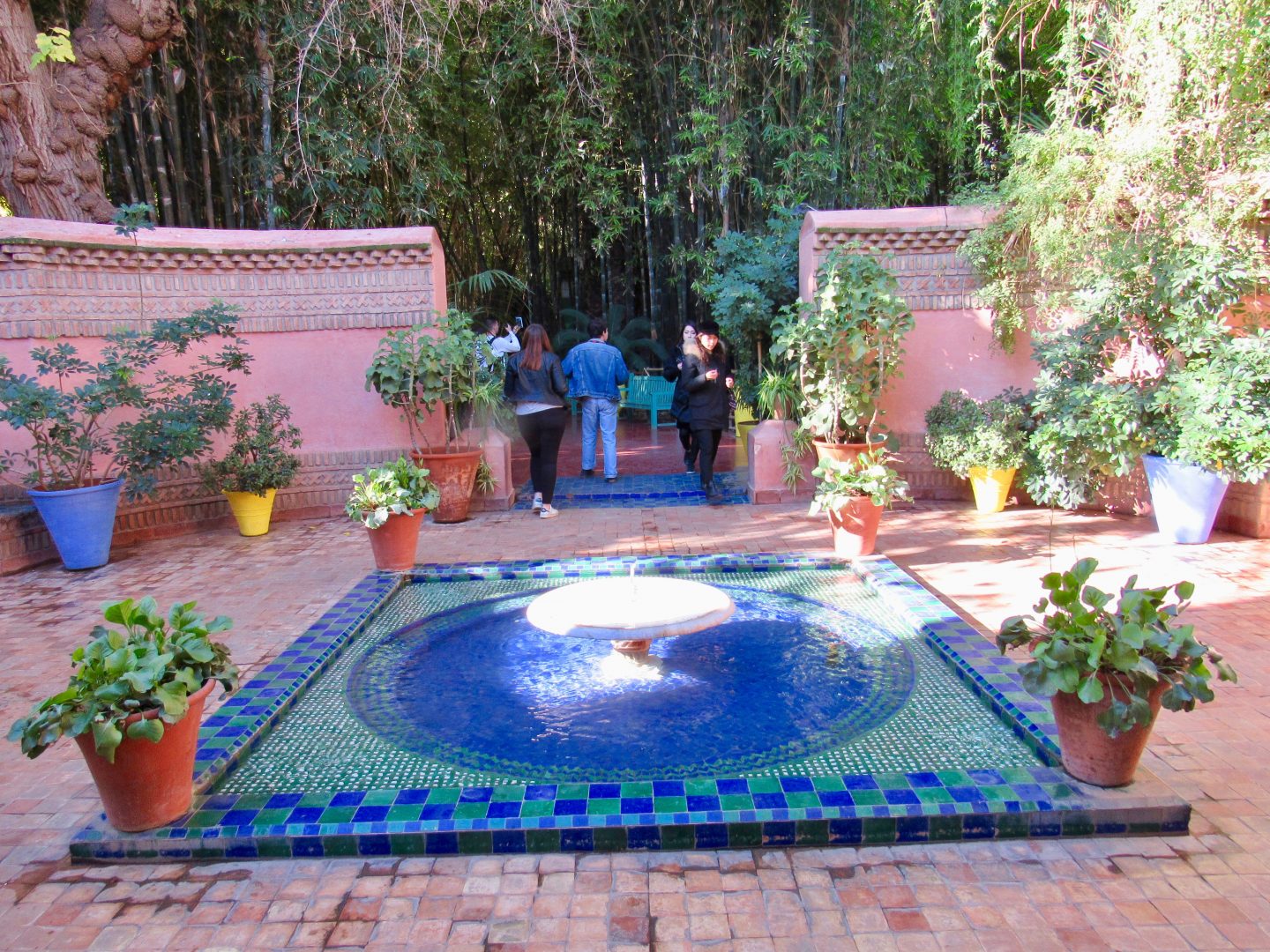
Un museo para conmemorar la vida del diseñador en Marrakesh
En el 2010, se hizo una exhibición de las piezas del diseñador en el museo beréber y fue un éxito. Hizo sentido construir un museo y por suerte, salió a la venta el pedazo de tierra junto a Villa Oasis. Pierre Bergé compra la tierra y le pide a los arquitectos de Studio KO que hagan un diseño moderno y a la vez muy de Marruecos. Ellos diseñaron el edificio como uno cortaría la tela para un traje, con curvas y lineas, utilizando dibujos hechos por Yves.

Siete años después abre el museo de terra cotta que costó $17 millones de dólares. Pierre Bergé pudo ver el museo completo, pero muerte justo antes que abriera al público. Al mismo tiempo abrió otro museo en el atelier de Yves Saint Laurent en Paris. Así que las personas pueden ver la vida y los trabajos del diseñador en sus dos hogares.

El museo tiene alrededor de 1,000 piezas del diseñador. Doscientos atuendos de un archivo de alta costura fueron enviados desde Paris. No te permiten tomar fotos en la mayoría del museo.

Me gusto mucho la librería fue inspirada por el diseño de boutiques de diseñador. Venden libros de moda y de Marruecos, joyería, accesorios, souvenirs y postales de la colección de LOVE. Por supuesto compre la postal del año de mi nacimiento.
